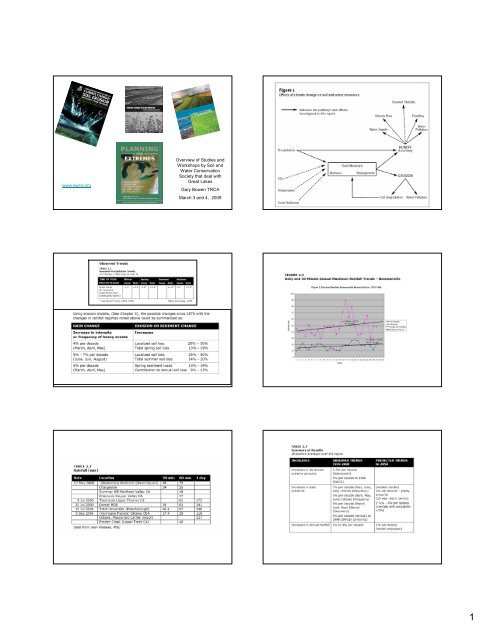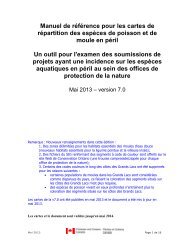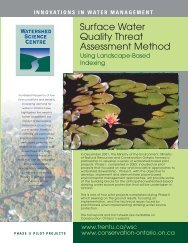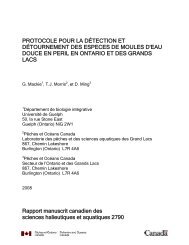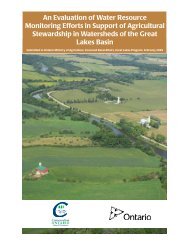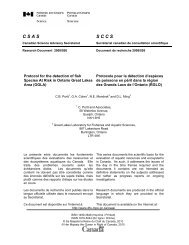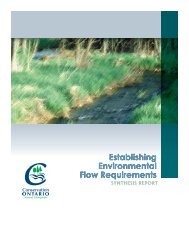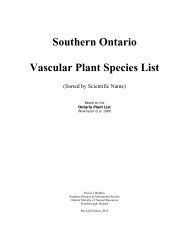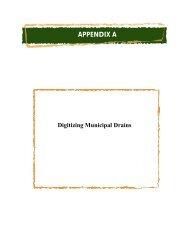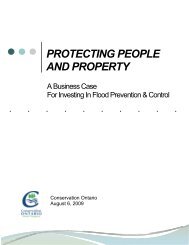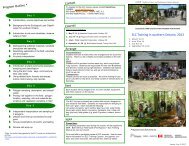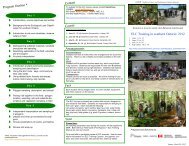Overview of Studies and Workshops by Soil and Water Conservation ...
Overview of Studies and Workshops by Soil and Water Conservation ...
Overview of Studies and Workshops by Soil and Water Conservation ...
You also want an ePaper? Increase the reach of your titles
YUMPU automatically turns print PDFs into web optimized ePapers that Google loves.
www.swcs.org<strong>Overview</strong> <strong>of</strong> <strong>Studies</strong> <strong>and</strong><strong>Workshops</strong> <strong>by</strong> <strong>Soil</strong> <strong>and</strong><strong>Water</strong> <strong>Conservation</strong>Society that deal withGreat LakesGary Bowen TRCAMarch 3 <strong>and</strong> 4, 20091
Thus it appears that changes in the short duration intensity factor, as well aschanges in daily falls are affecting the “R” erosivity factor in the soil lossequation.Overall we could expect a combined EI30 factor (RUSLE <strong>and</strong> RUSLEFACequations) to increase <strong>by</strong> the order <strong>of</strong> 5 x 3 = 15% per decade, with thefuture rate <strong>of</strong> change to 2050 not significantly different from that experiencedin the 1970 to 2000 periodFrom an erosion perspective it should be noted from the studies <strong>by</strong>Stone et al. (2000) <strong>and</strong> <strong>by</strong> Zhang et al. (2000) that the greatest one day(<strong>and</strong> probably shorter duration) increases have been in late Spring <strong>and</strong>early Summer, with lesser but significant increases in the March to Mayperiod, <strong>and</strong> this is likely to continue.NONPOINT SOURCE POLLUTION LIKELY TO INCREASEThe magnitude <strong>of</strong> nonpoint source pollution is the result <strong>of</strong>the interaction between (1) the physical l<strong>and</strong>scape, (2) thetype, intensity, <strong>and</strong> level <strong>of</strong> management <strong>of</strong> that l<strong>and</strong>scape,<strong>and</strong> (3) the frequency, intensity, timing, <strong>and</strong> volume <strong>of</strong>precipitation.Therefore, it is highly likely that a precipitation regime withmore frequent, more intense, <strong>and</strong>/or larger storms willincrease the severity <strong>of</strong> nonpoint source pollution.MANAGING RISK AT THE WATERSHED SCALEThe most compelling advantage <strong>of</strong> working at the watershed scale is theability to “focus for effect” to direct conservation efforts at the mostvulnerable parts <strong>of</strong> the l<strong>and</strong>scape <strong>and</strong> during the most vulnerable times <strong>of</strong>the year.Participants argued that working at the watershed or l<strong>and</strong>scapescale is the only way to deal with the <strong>of</strong>f-site effects in agriculturalwatersheds. <strong>Conservation</strong>ists “have to connect the dots—makesure our work on farms adds up—that the sum <strong>of</strong> our efforts isgreater than the parts.”Working at the watershed scale opens up opportunities to plan<strong>and</strong> implement different strategies that complement <strong>and</strong> increasethe benefits <strong>of</strong> in-field practices.Strategies to restore wetl<strong>and</strong>s, repair stream channels, <strong>and</strong>enhance riparian corridors are best implemented at thewatershed scale <strong>and</strong> will reinforce the benefits <strong>of</strong> work at the farmscale if the efforts are effectively targeted <strong>and</strong> coordinatedPublic policy must ensure a long-term commitment <strong>of</strong>people <strong>and</strong> resources to community-driven projects at thewatershed scale. The more traditional approach <strong>of</strong>providing short-term, three- to five-year grants tocommunities will not work.Sustained effort <strong>and</strong> support must be available to build thelocal infrastructure—leadership, technical support, <strong>and</strong>monitoring systems— essential to making effectiveadaptive management possible.More effective conservation assessment<strong>and</strong> planning tools will accomplish little,according to workshop participants,unless we find effective ways toincrease the use <strong>and</strong> implementation <strong>of</strong>conservation systems <strong>and</strong> to targetimplementation at the most criticalportions <strong>of</strong> farms <strong>and</strong> watersheds.2


